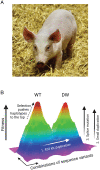Molecular genetic variation of animals and plants under domestication
- PMID: 35858409
- PMCID: PMC9335317
- DOI: 10.1073/pnas.2122150119
Molecular genetic variation of animals and plants under domestication
Abstract
Domesticated plants and animals played crucial roles as models for evolutionary change by means of natural selection and for establishing the rules of inheritance, originally proposed by Charles Darwin and Gregor Mendel, respectively. Here, we review progress that has been made during the last 35 y in unraveling the molecular genetic variation underlying the stunning phenotypic diversity in crops and domesticated animals that inspired Mendel and Darwin. We notice that numerous domestication genes, crucial for the domestication process, have been identified in plants, whereas animal domestication appears to have a polygenic background with no obvious "domestication genes" involved. Although model organisms, such as Drosophila and Arabidopsis, have replaced domesticated species as models for basic research, the latter are still outstanding models for evolutionary research because phenotypic change in these species represents an evolutionary process over thousands of years. A consequence of this is that some alleles contributing to phenotypic diversity have evolved by accumulating multiple changes in the same gene. The continued molecular characterization of crops and farm animals with ever sharper tools is essential for future food security.
Keywords: Mendel; crops; domestic animals; domestication; genetics.
Conflict of interest statement
The authors declare no competing interest.
Figures




References
-
- Purugganan M., What is domestication? Trends Ecol. Evol. 37, in press (2022). - PubMed
-
- Darwin C., On the Origins of Species by Means of Natural Selection or the Preservation of Favoured Races in the Struggle for Life (John Murray, London, United Kingdom, 1859).
Publication types
MeSH terms
LinkOut - more resources
Full Text Sources
Other Literature Sources
Medical

